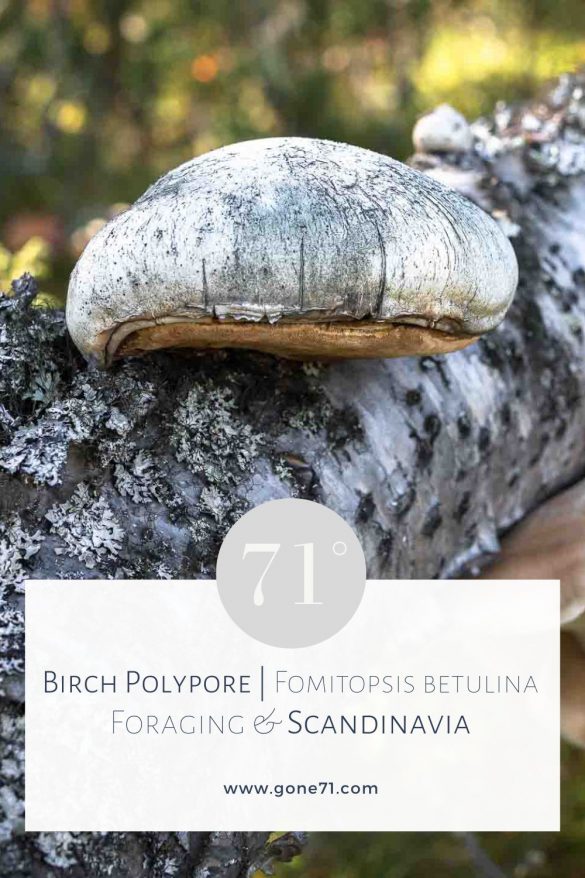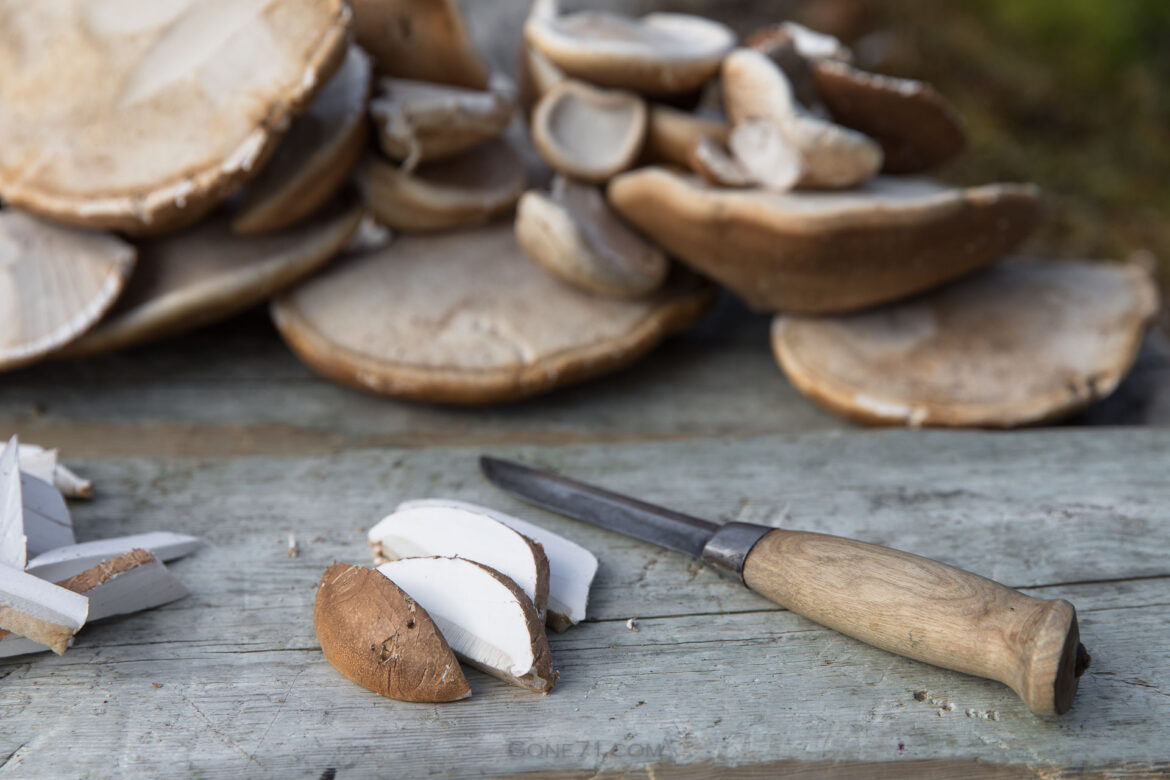swe.: Björkticka | nor.: Knivkjuke | fin.: Pökkelökääpä | dt.: Birkenporling, Birkenschwamm
With its soft-looking appearance, the birch polypore is one of our absolute favorite mushrooms. Admittedly, the culinary value is modest to non-existent, but the qualities of this mushroom lie somewhere else. The birch polypore is known for its medicinal properties and its positive effects on the human body.
You take what you have, and do what you can.
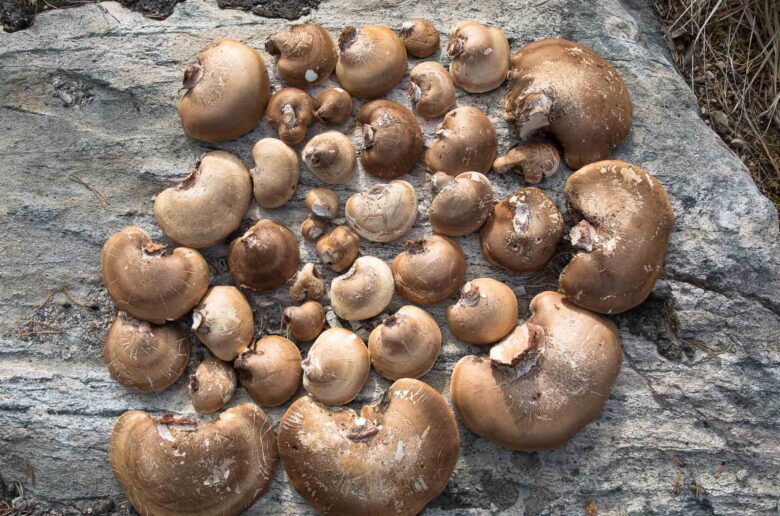
Birch polypore, an ancient remedy
This fungus has been used by humans for (medicinal purposes) thousands of years. The best-known find in this regard is that of the 5000 year old glacier mummy “Ötzi” in the Austro-Italian Alps. Two pieces of the birch polypore were found on him threaded on a leather tong. Researchers suspect that this man from the stone age used this fungus to treat gastrointestinal disorders – more specific, whipworm parasites in his case.
Til today, the birch polypore is considered a potent remedy in natural medicine for various diseases. It is usually consumed as an infusion drink, with particularly young specimens theoretically also being eaten.
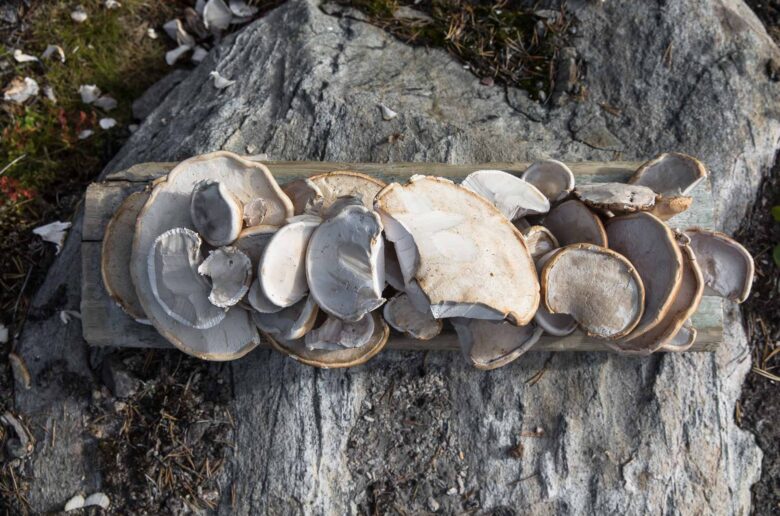
Medicinal effects of birch polypore
The mushroom has a very positive effect on the whole human body with no known side effects and is therefore very popular in natural medicine. Among other things, he helps with:
- stimulates bile and liver function
- antiviral
- antibacterial
- anti-inflammatory
- antifungal
- antiseptic
- strengthens the immune system
- relieves gastrointestinal problems.
- helps with hair loss
- helps with heartburn
- brittle nails
- sleep disorders
- migraine
- gas …
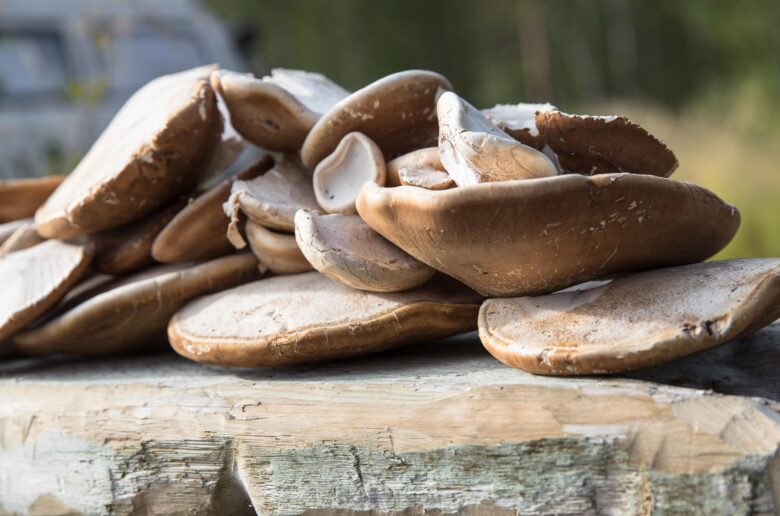
The most important ingredients include piptamine, nucleic acid, agaric acid, polysaccharides, betulinic acid, various vitamins and more. These ingredients have a strong antibacterial and antiviral effect. Studies have shown that the polysaccharides and betulinic acid contained in the mushroom in particular potentially inhibit the development of cancer cells.
The nucleic acid has antiviral effects and is said to protect the organism even against different types of corona and tick born encephalities.
It is also considered anti-inflammatory due to polyporenic acid contained in the mushroom. It also reduces bleeding. One application is to apply sliced mushroom pieces to the wound. The ingredients are also said to help minimize scarring. We have not tried that ourselves though. As with all naturopathic advice, this should be treated with caution. In the case of serious injuries, they can in no case replace a doctor.
In some European countries, the mushroom is used intensively against stomach problems, especially for healing and regeneration in stomach cancer.
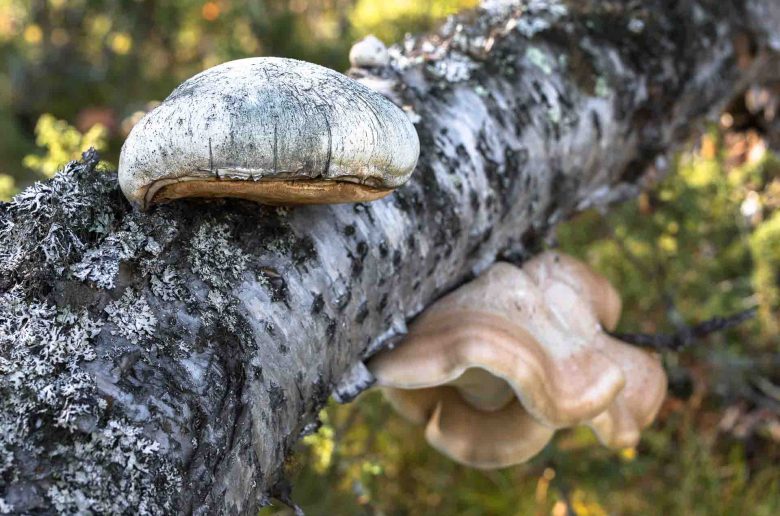
Birch polypore habitat
As the name suggests, the birch polypore grows exclusively on birch trees. In the Scandinavian countries, where the birch is one of the most common trees, it is therefore particularly common. But it is also not difficult to find in other Central European countries.
Birch polypores can take on a stately size and in some cases even reach a diameter of up to 30cm. Since it only grows on birch wood, it is usually very easy to identify. In young specimens, its flesh is still soft and resembles the consistency of cork. In older stages, the fungus hardens completely and the whitish fruiting body turns brownish with age.
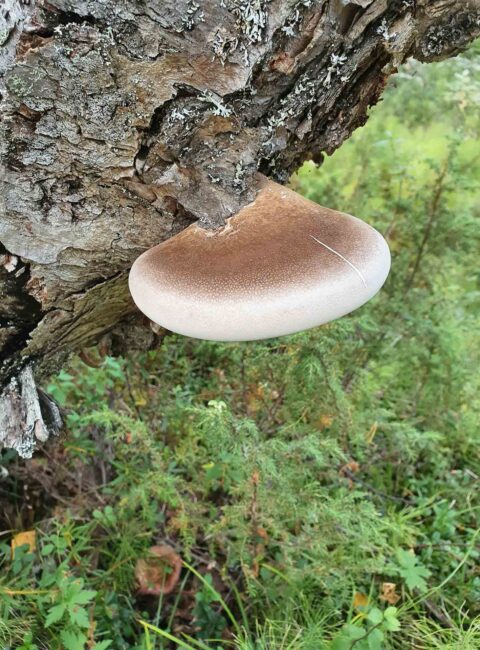
Birch polypore, a decomposer
Like other tree fungi, the birch polypore is a decomposer and infests dead or severely weakened birch trunks. It triggers dry rot in the tree and an infestation usually means the end for the birch if it is still alive.
The fruiting bodies of the birch polypore form in late summer and autumn each year and grow throughout the year. The fruiting bodies are harvested in late autumn, usually from November to spring. Adult specimens in which the ingredients and bitter substances are fully developed are used for medicinal purposes. If you are a culinary hardened person, you can dare to eat the very young specimens. They really don’t taste good though.
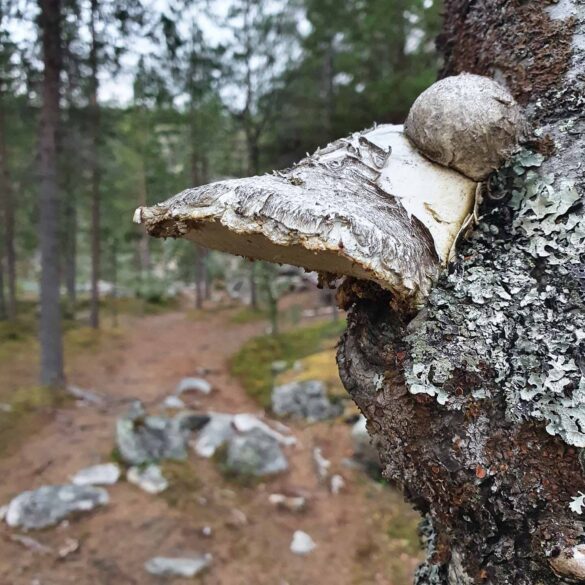
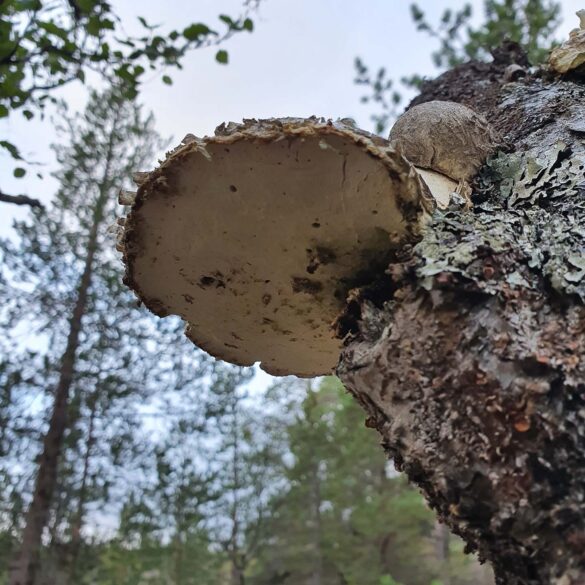
Look-Alikes
Although there are similar-looking tree fungi that can be confused, none of them grow on birch trees. So as long as you can identify birches correctly, there should be no confusion, at least in the European area that we know.
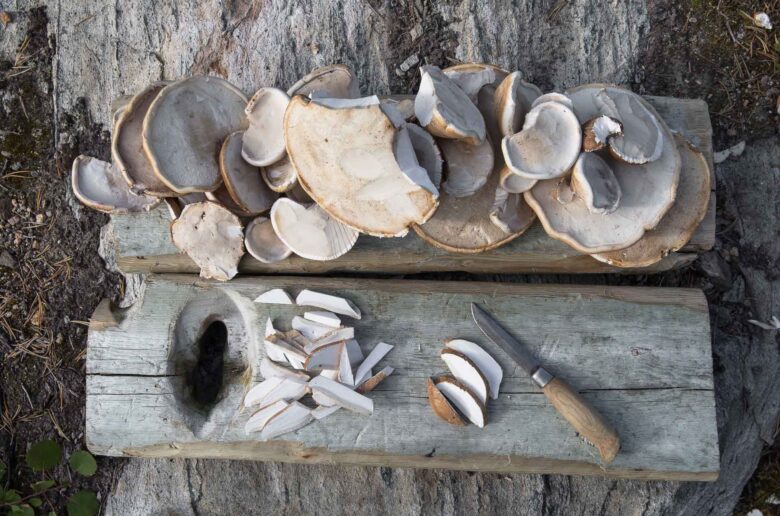
In the (medicinal) kitchen
Since we can’t recommend a recipe in good conscience that enhances the taste of this mushroom, we limit ourselves to the healing effect.
The classic use of this mushroom is as a tea or infusion drink.
- As a rule, the mushroom is cut into 0.5 – 1 cm thick slices and dried like any other mushroom.
- This drying process usually takes 2 to 4 days, with the mushroom being considered dry when it has lost its tough shape and become brittle.
There are different ways of preparing it. Some process the dried mushroom into mushroom powder. This is best done by hand with a mortar, as the consistency of the mushroom is usually unsuitable for mechanical devices such as mills.
However, it is also possible to boil the dried mushroom slices directly. For 1 liter of water you use about 4 slices of a medium-sized mushroom. When it comes to mushroom powder, we usually use one tablespoon per liter of water. If you want it stronger, you can use a little more.
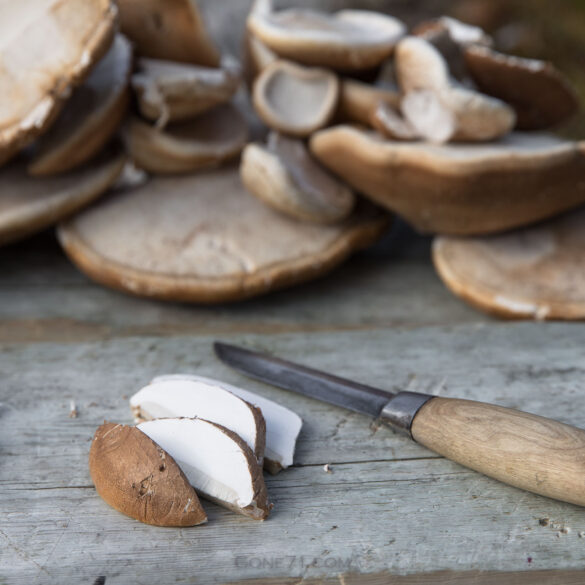
Birch polypore infusion
Ingredients
- 1 liter of water
- 1.5 tablespoons dried mushroom powder.
- 1.5 tablespoons of chamomile flowers
- honey on demand
Instructions
- Pour the boiling water over the mushroom powder and chamomile blossoms.
- Leave for 15 minutes and then strain out the chamomile blossoms.
- Add honey and stir to dissolve.
- Let the tea cool down and drink it (cooled down) over several hours.
- The procedure can be repeated for several days.
Notes
If you want to "improve" the idiosyncratic bitter taste, you can of course add other herbs such as chamomile or mint and sweeten it all with honey.
Also, if you use dried pieces you should cook them for at least one hour. Dried or fresh pieces of the mushroom need more time to give up their precious content.
Find some inspiration in other mushroom recipes
↓↓↓
We have compiled this overview with the best of knowledge and belief, but do not claim to be complete and reserve the right to make errors.
Learn more about poisonous mushrooms and mushroom poisons here
↓↓↓
